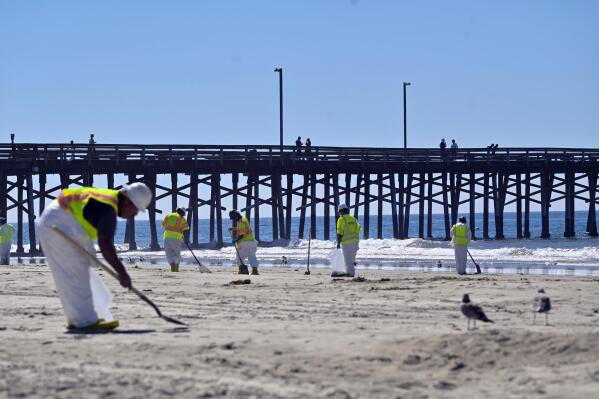Delay after alarm puts California spill response in question
Delay after alarm puts California spill response in question
Amplify Energy’s emergency response plan for a major oil spill like the one it’s now dealing with in coastal Southern California depended heavily on a quick shutdown of the San Pedro Bay Pipeline if its sensors picked up a sudden loss of pressure. That’s not what happened, investigators said.
After an alarm went off in a company control room at 2:30 a.m. Saturday — signaling a rupture that would spill tens of thousands of gallons of crude into the Pacific Ocean — the company waited more than three hours to shut down the pipeline, at 6:01 a.m., according to the preliminary findings of an investigation into the spill.
The Houston-based company took another three hours to notify the U.S. Coast Guard’s National Response Center for oil spills, investigators said, further slowing the response to an accident for which Amplify workers spent years preparing.
“How come it took so long? That’s a fair question,” said Richard Kuprewicz, a pipeline consultant and private accident investigator from Redmond, Washington. “If you have any doubt, your action should be to shut down and close. ... Something’s not quite right here.”
Pipeline control room alarms are fairly routine and don’t always mean a leak, according to Kuprewicz and other industry experts. They can be tripped by numerous factors — from a faulty signal from a sensor along the line, to a pump that goes off line and causes a sudden pressure change. But the alarms, which can include flashing lights, sounds or both, also are supposed to trigger immediate follow-up actions to quickly ascertain if anything is wrong.
It’s uncertain why that process dragged out hours in San Pedro Bay, potentially worsening a spill that left some birds coated with oil and has stirred worries about broader environmental impacts.
The cause of the pipeline break just offshore from Los Angeles remains under investigation. Early findings point to a ship anchor possibly catching the line and dragging it across the seafloor, tearing a gash in the half-inch-thick (12.7 millimeter) steel pipe.
Amplify’s CEO Martyn Willsher refused to directly answer questions about the alarm when pressed on the issue by reporters Wednesday. He repeated his assertion that the company didn’t learn of the spill until a boat saw a sheen on the water at 8:09 a.m..
“We are conducting a full investigation into that to see if there’s anything that should have been noticed,” Willsher said. He said the pipeline already was shut down by 6 a.m. Saturday, then re-started for five minutes for a “meter reading” before it was shut down again. Willsher did not say when it had been initially shut down or why.
Federal pipeline safety officials did not immediately respond to questions from The Associated Press about Willsher’s version of events. In documents released Tuesday detailing the company’s actions, federal investigators from the Pipeline and Hazardous Materials Safety Administration offered no explanation for the company’s alleged delay.
In August, Amplify boasted during a presentation to investors that it had “upgraded infrastructure to detect spills and other failures earlier” and in 2020 had achieved a roughly 50% reduction in spills that needed to be reported to authorities.
Before the spill, Amplify had high hopes for the Beta oil field and was pouring millions into upgrades and new drilling projects.
Problems with faulty leak detection procedures have plagued the industry for years, including during a massive 2010 oil spill that polluted 40 miles (64 kilometers) of Michigan’s Kalamazoo River. In that case, an Enbridge Inc. pipeline leaked at least 843,000 gallons (3.2 million liters) of crude over 17 hours, even as alarms kept going off in a company control room.
The company later settled pollution violations in the case for $176 million.
The accident spurred calls for more stringent leak detection rules and the installation of more automatic or remote-control shut-off valves that can quickly halt the flow of oil in a leak.
A dearth of such valves was also cited in another 2010 pipeline accident — a natural gas transmission line explosion in San Bruno, California, that left eight dead and dozens injured after the line continued burning like a massive blowtorch for almost 90 minutes before the line was shut down manually.
Federal officials began crafting new leak detection and valve rules under former President Barack Obama, but they were never finalized.
A new rule proposed last year under former President Donald Trump and now awaiting final approval would mandate more valves only for new or replaced oil pipelines, not the thousands of miles that are already in use. The change came after oil industry lobbying groups including the American Petroleum Institute said retrofitting lines with valves would cost up to $1.5 million per device.
The pending rule does not set standards for leak detections, giving companies significant leeway in how sensitive to leaks their equipment need to be, said Bill Caram with the Pipeline Safety Trust, a Bellingham, Washington-based group that advocates for safer pipelines.
“It makes us worry for our country’s aging energy infrastructure,” Caram said. “We fear this could become a bigger and bigger issue.”
John Stoody with the Association of Oil Pipe Lines said companies and industry groups are working hard to improve leak detection technologies. Fine-tuning equipment is part of that, to make sure companies can detect even small leaks but not have to respond to false alarms.
“If you’re riddled with false alarms, people have a harder time reacting,” Stoody said.
___
Associated Press writer Bernard Condon in New York contributed to this report.
___
Follow Matthew Brown on Twitter: @MatthewBrownAP
___
This version corrects that the spelling of the last name of Amplify Energy’s CEO is Willsher, not Willshire.







